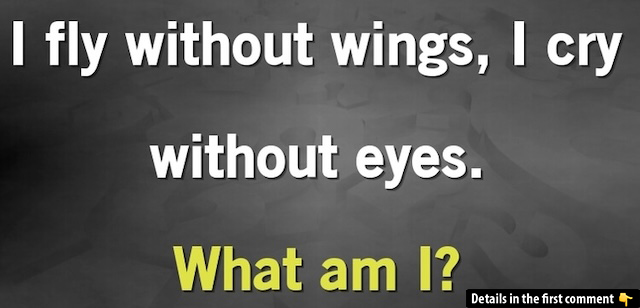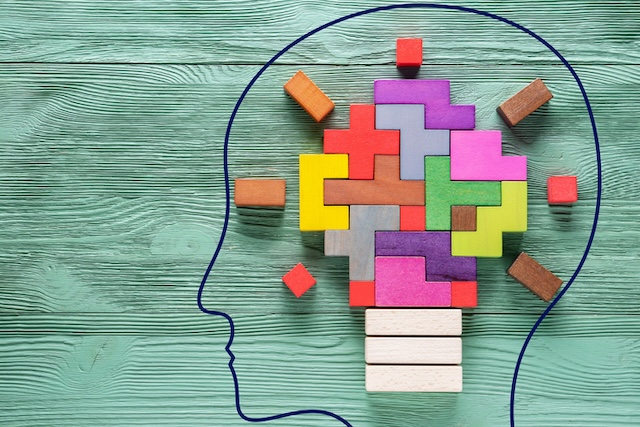Are you ready to give your brain a workout? Here’s a timeless riddle that’s sure to get your gears turning:
“I fly without wings, I cry without eyes. What am I?”
At first glance, this riddle might sound simple, but don’t be fooled—it’s trickier than it seems! It’s the kind of brain teaser that invites you to think outside the box, challenging your mind to find creative and unexpected solutions. Take a moment to ponder it before scrolling down for the answer!

Why Riddles Like This Are So Engaging
Riddles are more than just a fun pastime—they’re a fantastic way to sharpen your critical thinking skills. They force you to consider multiple perspectives, connect abstract ideas, and question assumptions. This particular riddle is a perfect example of how language can play with our minds, making us interpret words in unique ways.
So why do we love riddles? They’re like mental puzzles, testing our creativity and logic at the same time. Plus, solving one provides that satisfying “Aha!” moment when everything clicks into place. Let’s dive deeper into how to solve this classic riddle and why it continues to captivate minds of all ages.
Common Missteps When Solving the Riddle
Before we reveal the answer, let’s look at some common mistakes people make when trying to solve it. The first line, “I fly without wings,” often leads people to focus on physical things that move through the air. Birds, insects, planes—these are all logical guesses, but they don’t fit the second part of the riddle.
The phrase “I cry without eyes” is where most people stumble. It’s natural to think of living things that cry, like humans or animals, but this is a classic trap in riddles. The key is to shift your perspective. Instead of focusing on living beings, consider inanimate objects or natural phenomena. The answer lies in thinking metaphorically rather than literally.
Step-by-Step Breakdown of the Riddle
Let’s break the riddle into its two parts to uncover the answer:
- “I fly without wings”: This part refers to something that moves or drifts through the air. It’s not a bird or insect, so what else could it be? Think about things that naturally float, glide, or soar without requiring wings.
- “I cry without eyes”: The word “cry” here is used figuratively. It doesn’t mean shedding tears from eyes but rather releasing moisture or water. What could “cry” in this way?
When you put these two clues together, the answer becomes clear: a cloud.
The Answer: A Cloud
A cloud fits the riddle perfectly. It “flies” through the sky without the need for wings, drifting gracefully on air currents. And when it rains, it “cries” by shedding water droplets—despite not having eyes. The metaphorical language of the riddle cleverly describes the natural behavior of clouds, making it a beautiful example of how riddles play with words and meanings.

The answer to the riddle: a cloud! It flies through the sky without wings, and it cries without eyes when it rains. Did you guess correctly? Let us know!
The Fascinating Role of Clouds in Nature
Now that we know the answer, let’s take a moment to appreciate clouds. These floating wonders of the sky aren’t just poetic subjects for riddles—they’re also an essential part of Earth’s ecosystem. Clouds regulate temperature, bring rainfall, and create breathtaking displays at sunrise and sunset. They might seem ordinary, but they’re vital for life as we know it.
Imagine the next time you see a cloud drifting lazily across a blue sky. It’s not just a patch of vapor—it’s a natural marvel that inspired this timeless riddle.
Why Riddles Boost Your Brainpower
Solving riddles like this one isn’t just fun—it’s also good for your brain. Here’s how:
- Improves Problem-Solving Skills: Riddles force you to think critically and analyze information from different angles.
- Enhances Creativity: They challenge you to interpret words and phrases in unconventional ways, stretching your imagination.
- Encourages Logical Thinking: Riddles often involve clues that require logical connections, honing your reasoning abilities.
- Promotes Focus: To solve a riddle, you need to concentrate, block out distractions, and focus on the task at hand.
Think of riddles as a gym for your mind. Each one you solve strengthens your mental muscles, helping you tackle challenges in everyday life with greater ease and creativity.

Challenge Your Friends with This Riddle
Now that you know the answer, why not share this riddle with your friends and family? See how quickly they can solve it—or watch as they scratch their heads trying to figure it out. You might even spark a friendly debate or a lively conversation about other riddles and brain teasers.
Remember, riddles are meant to be shared. They’re a great way to connect with others, spark curiosity, and keep your mind sharp.
Conclusion: A Timeless Brain Teaser
“I fly without wings, I cry without eyes.” At first, it might seem impossible to solve, but once you shift your thinking and embrace the metaphor, the answer—a cloud—becomes clear. This classic riddle is a reminder of the power of language to challenge and delight us. It encourages us to think creatively, question assumptions, and see the world in new ways.
So the next time you’re in need of a mental workout or just want to impress someone with a clever brain teaser, remember this riddle. It’s more than a fun challenge—it’s a window into the beauty of abstract thinking. Keep exploring, keep questioning, and most importantly, keep having fun with riddles like this one!